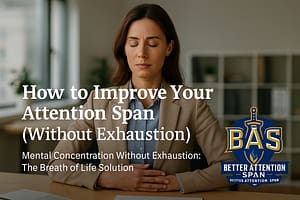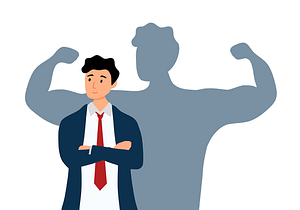Mental Concentration Without Exhaustion: The Breath of Life SolutionMental Concentration is not

Disruptive Digital Technology and Social Media Companies have evolved over the past few decades into festering hotspots responsible for a virulently unstoppable worldwide epidemic of mental addiction. Pharmaceutical companies are already prepared to bank many billions off the resulting, widespread Attention Deficits that about which Neuroscience is already sounding the alarm. And to think we're only at the initial post-Covid swell of a rising tide that will become an Attention Deficit Tsunami to far outweigh ADHD (Attention Deficit Hyperactivity Disorder, formerly known as ADD without the H).
As the world continues to become more digitized, social media has become an integral part of our daily lives. With the rise of platforms like Facebook, TikTok, LinkedIn, YouTube, Pinterest, and Instagram, it's easier than ever to stay connected with family and friends, share information, and stay up to date on current events.
However, the constant notifications, updates, and endless scrolling can lead to a phenomenon known as social media distraction. In this article, we'll explore the impact of social media distraction on productivity, the science behind social media addiction and attention span, and strategies to help minimize its effects.
Social media addiction is a real phenomenon that affects millions of people worldwide. According to a study conducted by the Pew Research Center, 69% of adults in the United States use social media, and 51% of these users visit these sites multiple times a day. The reason why social media can be so addicting is that it activates the reward centers in our brain. Every time we receive a notification or like on a post, our brain releases dopamine, a chemical that makes us feel good. The more we engage with social media, the more our brains crave that dopamine hit, leading to addictive behavior.
Another factor that contributes to social media addiction is our attention span. Research has shown that the average human attention span has decreased from 12 seconds in 2000 to 8 seconds in 2021. This decline is due to the constant bombardment of information that we experience in our daily lives. With so much information competing for our attention, it's easy to get distracted and lose focus on the task at hand.
The impact of social media distraction on productivity is significant. Studies have shown that employees spend an average of 2.5 hours per day on social media during work hours, costing companies billions of dollars in lost productivity each year. In addition, social media distraction can lead to increased stress levels, decreased job satisfaction, and even burnout.
Facebook is one of the most commonly used social media platforms, with over 2.7 billion active users worldwide. According to a survey conducted by the American Psychological Association, 86% of adults who use Facebook reported logging on at least once a day, and 52% reported checking their accounts several times a day. This constant checking of notifications and updates can lead to a significant decrease in productivity.
TikTok, the popular short-form video app, has exploded in popularity in recent years, with over 1 billion active users worldwide. According to a survey conducted by the Royal Society for Public Health, TikTok is the most addictive social media platform, with 37% of users reporting that they spend more time on the app than they intended to. This addiction can lead to decreased attention span and decreased productivity.
There are many different types of social media distractions, each with its unique set of challenges. Facebook is known for its constant updates and notifications, making it easy to get sucked into scrolling through your newsfeed instead of focusing on work. TikTok's short-form videos are designed to be addictive, leading to a decrease in attention span and productivity. LinkedIn can be distracting with its constant stream of job updates and networking opportunities, while YouTube's suggested videos can keep you glued to the screen for hours. Pinterest and Instagram's endless scrolling can lead to a decrease in productivity and an increase in stress levels.
Social media distraction can have a significant impact on work productivity. It can lead to decreased attention span, increased stress levels, and even burnout. In addition, social media distraction can lead to decreased job satisfaction and lower quality of work. When we're constantly checking our social media accounts, we're not giving our full attention to the task at hand, leading to mistakes and decreased productivity.
There are several strategies you can use to limit social media distraction and improve productivity. The first step is to recognize when you're getting distracted. Set limits on the amount of time you spend on social media each day and stick to them. You can also use apps like Freedom or StayFocusd to block social media sites during work hours.
Another strategy is to take breaks. When you're feeling overwhelmed or distracted, take a short break to clear your mind. You can go for a walk, practice meditation, or read a book to help refocus your attention.
Finally, it's essential to prioritize your tasks. Make a to-do list each day and prioritize the most important tasks first. This way, you'll be less likely to get distracted by social media and more focused on completing your work.
There are several tools and apps you can use to help minimize social media distraction. One popular tool is the Pomodoro Technique, which involves working for 25 minutes and then taking a short break. This technique can help you stay focused and productive.
Another strategy is to use apps like RescueTime, which tracks the amount of time you spend on different websites and apps. This information can help you identify where you're spending the most time and make changes to your behavior.
Finally, there are several browser extensions that can help block social media sites during work hours, including Freedom, StayFocusd, and Cold Turkey.
Employers have a role to play in managing social media distraction in the workplace. They can set clear guidelines and expectations for social media use during work hours and provide training on how to minimize distractions. Employers can also provide tools and apps to help employees stay focused and productive.
Finally, employers can create a culture of productivity by encouraging breaks, setting realistic goals, and recognizing employees' achievements. By creating a positive work environment, employees will be more motivated to stay focused and productive.
Social media distraction is a significant challenge in today's digital age. With the constant bombardment of information, it's easy to get distracted and lose focus on the task at hand.
However, there are several strategies you can use to minimize social media distraction and improve productivity, including setting limits on social media use, taking breaks, and prioritizing tasks.
Employers also have a role to play in managing social media distraction in the workplace by setting clear guidelines, providing training, and creating a culture of productivity. By training your attention to overcome damage from digital technology, you can improve your productivity and achieve your goals.

Mental Concentration Without Exhaustion: The Breath of Life SolutionMental Concentration is not

Fear Cannot Coexist with The Breath of LifeWhen stepping into The Breath

The Breath of Life Breathing PatternA Breath-Fueled Mental Focus Machine — Adjustable,

Attention Span Training Drills and DisciplineEnlarge Your Power of PerceptionImproving your Attention

"Stride from Breath to Breath Rather than Thought to Thought."From The Ministry

ATTENTION ALLOWS YOU TO TAKE INVENTORY OF YOUR ATTITUDE - SEEING THE